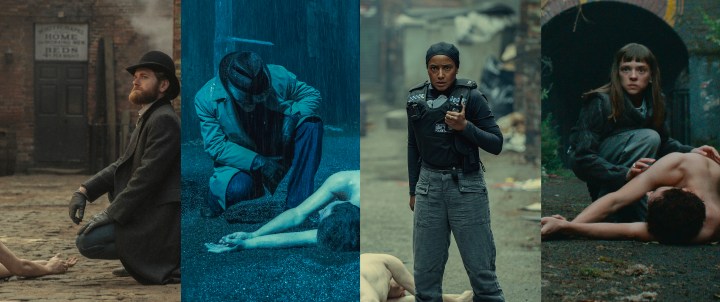WHAT WE’RE WATCHING
Time travel murder mystery: ‘Bodies’ – let them hit the floor

Four historical periods. The same dead body popping up in all of them. Providing a break from scary stuff this October, but not short on dark thrills, is Netflix’s ‘Bodies’, a twisty police procedural entwined with science fiction and period drama.
‘I don’t want to talk about time travel because if we start talking about it then we’re going to be here all day talking about it, making diagrams with straws.” That’s a line from Rian Johnson’s time-leaping actioner Looper. It’s also some excellent advice if you want to maximise your enjoyment of Bodies, a new Netflix series out of Britain, which blends science fiction, police procedural and period drama.
Based on writer Si Spencer and various artists’ eight-issue DC Vertigo miniseries, Bodies has one helluva plot hook: four detectives, decades apart, find the same naked, mutilated body in a backstreet of Whitechapel, London. As these police officers – Alfred Hillinghead (Kyle Soller) in 1890, Charles Whiteman (Jacob Fortune-Lloyd) in 1941, Shahara Hasan (Amaka Okafor) in 2023, and Iris Maplewood (Shira Haas) in 2053 – try to unravel the mystery, they find themselves chest-deep in a bizarre and deadly conspiracy spanning centuries.
It’s challenging to talk about Bodies because there’s much to spoil. In short, it’s one of those series that you want to like more than you ultimately do. Bodies starts incredibly compelling, but runs out of plot in the later episodes of its eight-part batch, instead becoming mired in wibbly wobbly, timey wimey stuff peppered with plot holes.
For the record, Bodies embraces one of the signature time paradoxes, but it’s a bizarre creative choice that only complicates matters, pulling viewers out of the show as they question the logic of its inclusion. The same can be said of the way the series chucks in a world-changing event, which would have decades of fallout for England’s capital.
It’s annoying because there’s a lot to like about Bodies. The series has a substantial amount of visual flair, using split screens on multiple occasions to show the activities of its leads simultaneously. On that note, it’s a smart thematic touch that all of the police detectives in Bodies are outsiders in some way, whether it be because of their ethnicity, religion, sexual orientation or physical ability. Their status automatically sees them distrusted or dismissed by colleagues, which makes it difficult for their far-fetched claims to be accepted.
Bodies pushes the limits of character sympathy in some cases, meaning viewers are likely to prefer spending time in one era over others. In terms of performances, Okafor is arguably strongest, as DS Hasan, whose street-level origins and innate sympathy mean she has a special ability for getting through to people. Haas, as Maplewood, is also interesting as a more ambiguous figure who has been sipping the government Kool-Aid, although the actress’s work is often undermined by her shaky British accent.
From a production standpoint, it’s hard enough to accurately represent one unique time period, let alone the present day and three others. Bodies impresses with how it captures Victorian London, its Blitzed World War 2 version, the present day, and future versions. The series predicts urban living three decades from now in a credible way, lightly layering on distinction from our reality, which is no easy feat. That said, it does feel like most of Bodies’ budget went into replicating and creating eras from scratch. The practical effects are solid barring a distracting contact lens choice for one character, but the CGI is notably poor.
Bodies’ biggest crime, though, as already mentioned, is the handling of its narrative. The series feels like it would have benefited from being a couple of episodes shorter, and tighter. Once Bodies is done with its enjoyable plot twists and dark reveals, it spends the rest of its run time clumsily hammering out a villain origin story that uses the trite “didn’t get enough love and acceptance in childhood” as its foundation. Not even an intriguing development in the final seconds of the last episode – which opens the door for a second season – can stop the yawns, eye rolls or head-scratching as the credits roll, which is disappointing given how electrically things started. DM
This story was first published on Pfangirl.com
Bodies was released on Netflix in its entirety on 19 October.




















 Become an Insider
Become an Insider
I enjoyed this series. Any movie or series billed as science fiction requires one to suspend belief for a while and this series was no exception. Yes, there are plot holes, and the end got a bit muddled, but it was a clever piece using time travel as the base for four intertwined stories.